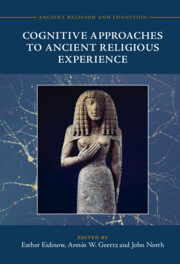Book contents
- Cognitive Approaches to Ancient Religious Experience
- Ancient Religion and Cognition
- Cognitive Approaches to Ancient Religious Experience
- Copyright page
- Contents
- Figures and Tables
- Contributors
- Abbreviations
- Funder Acknowledgement
- Introduction
- Part I Ritual
- Part II Representation
- Chapter 3 Ancient Greek Smellscapes and Divine Fragrances
- Chapter 4 Belief, Make-Believe, and the Religious Imagination
- Chapter 5 Chanting and Dancing into Dissociation
- Part III Gender
- Part IV Materiality
- Part V Texts
- Index
- References
Chapter 5 - Chanting and Dancing into Dissociation
The Case of the Salian Priests at Rome
from Part II - Representation
Published online by Cambridge University Press: 28 July 2022
- Cognitive Approaches to Ancient Religious Experience
- Ancient Religion and Cognition
- Cognitive Approaches to Ancient Religious Experience
- Copyright page
- Contents
- Figures and Tables
- Contributors
- Abbreviations
- Funder Acknowledgement
- Introduction
- Part I Ritual
- Part II Representation
- Chapter 3 Ancient Greek Smellscapes and Divine Fragrances
- Chapter 4 Belief, Make-Believe, and the Religious Imagination
- Chapter 5 Chanting and Dancing into Dissociation
- Part III Gender
- Part IV Materiality
- Part V Texts
- Index
- References
Summary
Starting from a cognitive point of view, this paper provides an entirely new reading of the dances and chants of the Salian priests. By focusing on their dances and chants in the perspective of embodied cognition and by putting a diligent analysis of (a) the reports and (b) the prayer texts into historical comparisons with other ‘prophetic’ practices of that time, this study is able to elucidate the Salian performances as body techniques that go beyond a mere facilitation of sociality. These techniques alter the practitioners’ states of mind and thereby elicit an experience that one may call religious experience, divine experience, or ‘possession’.
Keywords
Information
- Type
- Chapter
- Information
- Cognitive Approaches to Ancient Religious Experience , pp. 118 - 142Publisher: Cambridge University PressPrint publication year: 2022
